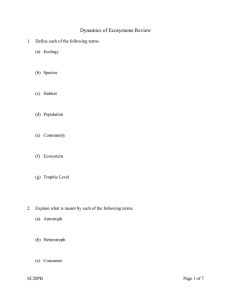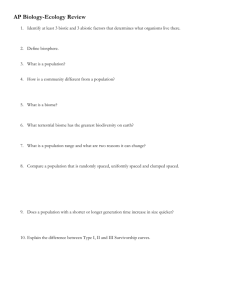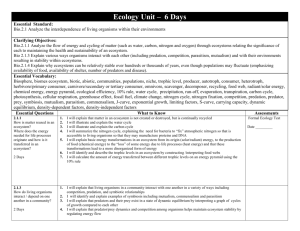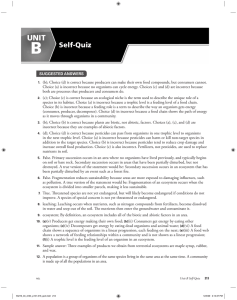Dynamics of Ecosystems Review
advertisement
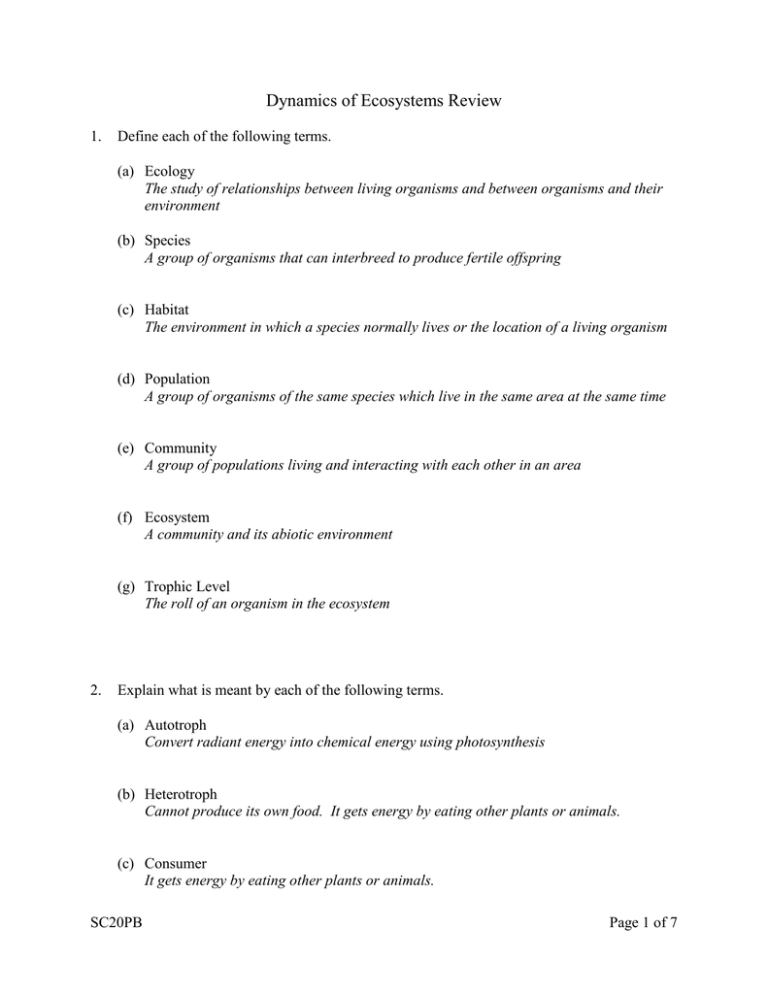
Dynamics of Ecosystems Review 1. Define each of the following terms. (a) Ecology The study of relationships between living organisms and between organisms and their environment (b) Species A group of organisms that can interbreed to produce fertile offspring (c) Habitat The environment in which a species normally lives or the location of a living organism (d) Population A group of organisms of the same species which live in the same area at the same time (e) Community A group of populations living and interacting with each other in an area (f) Ecosystem A community and its abiotic environment (g) Trophic Level The roll of an organism in the ecosystem 2. Explain what is meant by each of the following terms. (a) Autotroph Convert radiant energy into chemical energy using photosynthesis (b) Heterotroph Cannot produce its own food. It gets energy by eating other plants or animals. (c) Consumer It gets energy by eating other plants or animals. SC20PB Page 1 of 7 (d) Detrivoire ingest dead organic matter (e) Saprotroph live on or in non-living(dead) organic matter, secreting digestive enzymes into it and absorbing the products of digestion (f) Nitrogen fixation the process of taking nitrogen from the atmosphere and converting it into compounds that plants can use 3. Draw and label a diagram of the carbon cycle showing the processes involved (photosynthesis, cellular respiration, feeding, death, fossilization, and combustion). 4. Explain why farmers used to plant beans or clover in a field every so often instead of the regular crop. Nitrogen fixing bacteria live in nodules on the roots of these plants. Planting these plants allows these bacteria to add nitrogen compounds to the ground so that plants could use them. SC20PB Page 2 of 7 5. Provide an example of how human activities can impact either the carbon or nitrogen cycle. burning organic material (any reasonable example) 6. Provide an example of a natural occurrence that can impact the carbon cycle. volcano (any reasonable example) 7. A substance must have certain properties before it could be considered hazardous to an ecosystem. What are these four properties? long-lived mobile soluble in fat biologically active 8. What is the initial source of energy for almost all communities? sunlight (Note: You cannot just say the sun, because it is not the physical object that provides the energy but rather the light from it.) 9. Describe what is meant by food chain. A sequence showing the feeding relationships and energy flow between species The direction of each arrow shows which way the energy flows 10. Indicate the tropic level of each organism in the following food chain: algae → mosquito larva → dragon fly larva → fish → raccoon algae – producer; mosquito larva – primary consumer; dragon fly larva – secondary consumer; fish – tertiary consumer; raccoon – quaternary consumer SC20PB Page 3 of 7 11. Construct a food web for Arctic tundra using the following information about the ecosystem. Label the producers, primary consumers, and secondary consumers. • • • • SC20PB Cotton Sedges (a type of plant) is eaten by caribou, voles, lemmings, ground squirrels, jaegers, grizzly bears caribou are eaten by wolves voles and lemmings are eaten by wolves, wolverines, jaegers, gulls, weasels, owls, hawks ground squirrels are eaten by wolves, wolverines, weasels, owls, hawks, and grizzly bears Page 4 of 7 12. Explain how energy flows through a food chain. Energy from sunlight → producers → primary consumers → secondary consumer 13. A pyramid of energy shows the flow of energy from one trophic level to the next in a community. Explain the shape of the pyramid. Each level is smaller than the one below it because less energy flows through each successive trophic level. Energy is lost at each trophic level, so less remains for the next level. 14. Explain what is meant by the carrying capacity of an ecosystem. The largest population of a species that an environment can support 15. List three factors that set limits to population increase. Materials and energy, food chains, competition, density SC20PB Page 5 of 7 16. State whether each of the following factors for population growth are density-dependent or density-independent and explain why. (a) fire density independent natural disaster (b) drought density independent natural disaster (c) food supply density dependent the more of an organism the less food to go around (d) mating opportunities density dependent a decrease in population will result in fewer mating opportunities 17. Explain how population size is affected by (a) natality births increase the population (b) immigration organisms moving into the area increase population (c) mortality deaths decrease population (d) emigration organisms leaving an area decrease population SC20PB Page 6 of 7 18. Sketch a graph showing population growth and label the exponential growth phase, the transitional phase, and the plateau phase. 19. Explain each phase of a population growth curve and provide a reason why it occurs. exponential growth phase • population grows at an increasing rate (rapid increase in population) • many offspring survive • birth rate higher than death rate • many offspring reproduce • each generation produces more offspring that the last transitional phase • slowing of growth • factors limiting growth start having an affect plateau phase • population levels off • population reaches its carrying capacity • limiting factors control population such that average growth rate is zero SC20PB Page 7 of 7


